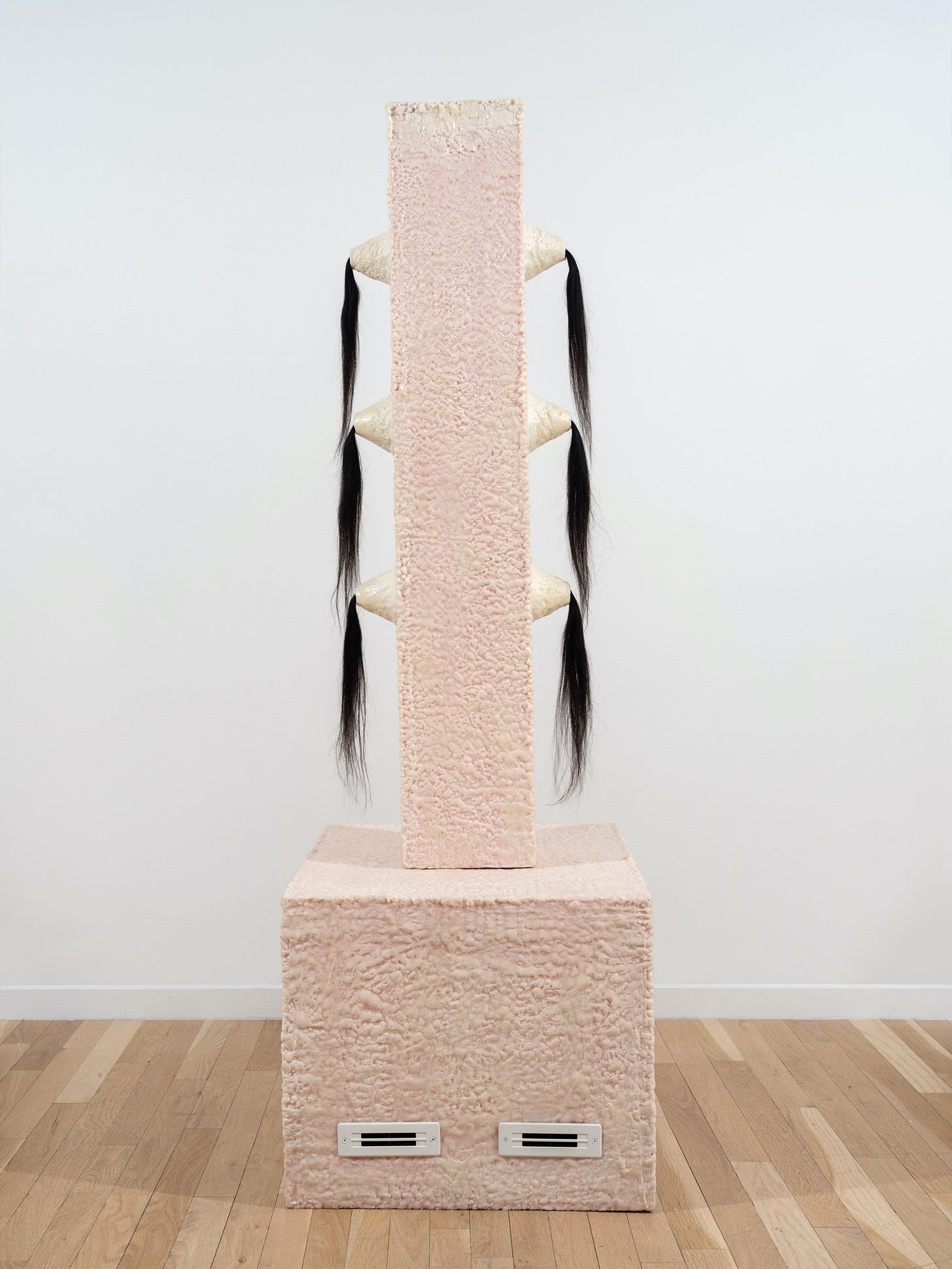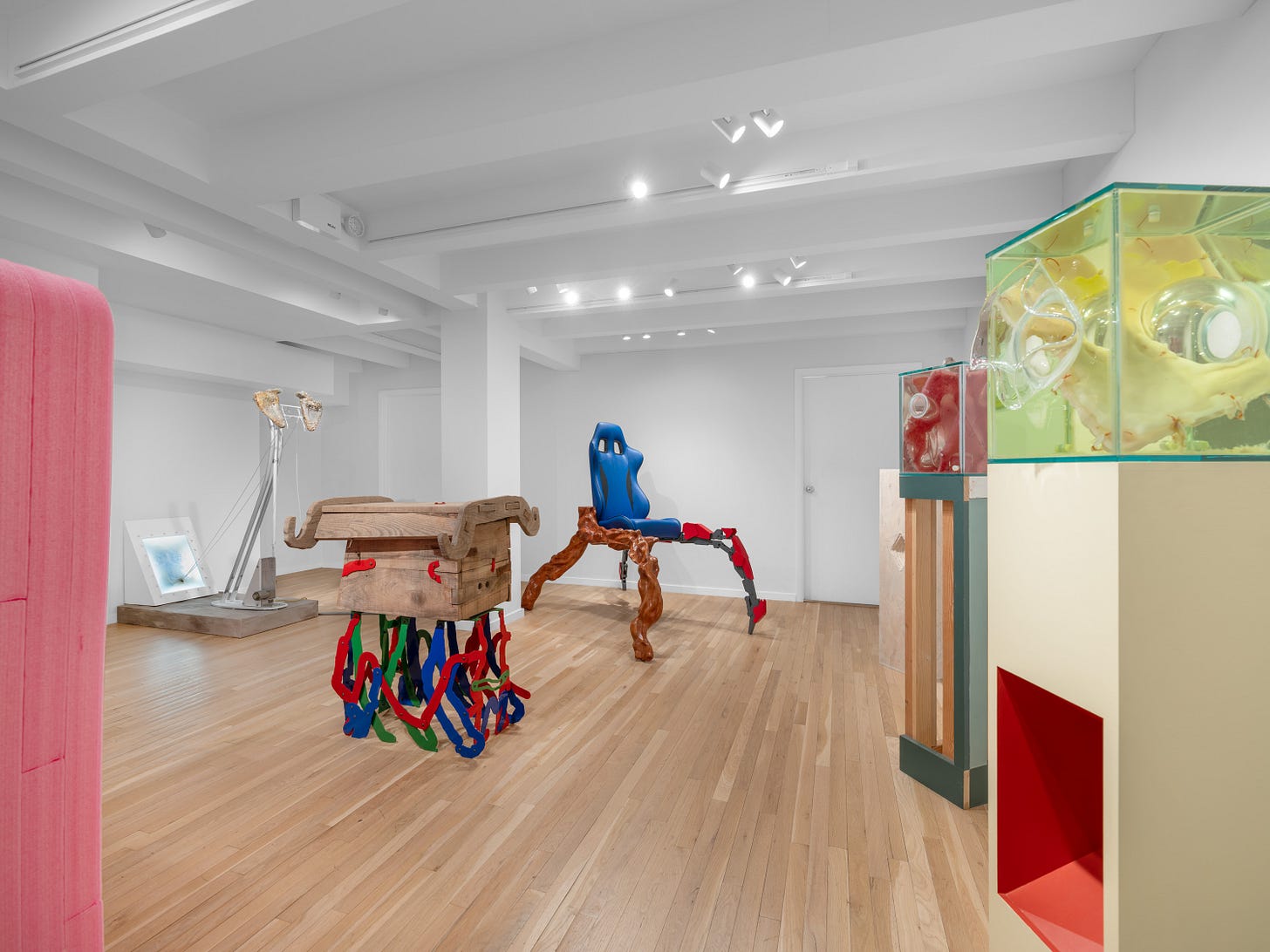Fleshy Machines, Metal Muscles
Some useless thoughts on the useless cyborgs at Brecht Wright Gander’s Body Objects
Earlier this year, the mouth of the subway smelled like piss and doughnuts as it spit me onto the street. I was going to an art exhibition and wearing leather boots and my feet ached. I looked around at the others in their dark clothes and scarves, coming and going—little vascular beings pumping life into the streets of New York, flowing in and out of this massive organic-inorganic feeling machine.
Room 57 Gallery sat low on the street in a grey-brick building made greyer by the passing of the sun behind the heights of Midtown. If it wasn’t for arty-looking people gathered out front smoking and in the wide, street-facing windows, one might have thought it was a hotel. A wavy jet-black awning hung over its entrance. A normal scene for an extremely strange, thought-provoking exhibition.
Brecht Wright Gander has made a name for himself as an artist and writer, creating machine-like pieces that challenge the parameters of aesthetics and function, usually equipped with combinations of industrial materials, household objects, rubbery representations of orifices, like in his infamous piece Another Fucking Lamp – within which early Cronenberg meets the Jetsons.
His group show at Room 57, called Body Objects, adhered closely to the themes already present in his work. The pieces ranged from a shingled room with dormers that form a face by Sam Stewart (Sleepy Head 2022) to biological sculptures by Jennifer Sirey, where cultures are encased in translucent boxes. On the show were things that looked like beings and living things that looked like inanimate objects.
Gander was clear about the aims of the exhibition: to challenge the difference between the “grown” and “made”, made starker by the current artificial intelligence craze, but also the uncertainty and strangeness in how mechanical thinking shapes the way we view the living human body itself—he cited pessimist philosopher John Gray’s conception of the human body as a “a civil war on legs” when talking about a piece by designer Serban Ionescu’s wooden box suspended on colorful, unruly stilts.
The most interesting pieces sat somewhere in the middle of the thing/being spectrum and played with the idea of work and function, mixing hydraulic movements with organic ones in disconcerting ways. The symbol of the body was recast in machines that move but towards no real goal, and single hydraulic functions were stripped from the whole: fleshy machines, metal muscle. Here, repetitions that originate in human movements—imbued with purpose, even if relative—are projected into some humanless future.
During the height of the Industrial Revolution and modernity, the ruins of society were always viewed as decaying: factories without purpose, rotting and falling back into the earth. However, with synthetic materials like plastic, these visions of a humanless future are less clear. We see plastic and resins and we see a sense of permanence, monuments to a pointless economy projected into the future. Like literary theorist Ranjan Ghosh tells us, contemporary materials both connect us to the whole and to the future and separate us from something essential. The plastic bottle may outlast the cerebellum and the Sphinx, telling our story after we are gone.
Most indicative of this connection/disconnection with the synthetic was a mechanical sculpture by sisters Georgia B. Smith and Zelda Smith called A Cultivated Atmosphere / A Narrowing Corridor II (2024). The sculpture resembled an ineffable exercise machine with white-painted steel aspects grounding a vertical piston and slanted lever with two bone-shaped pieces of mycelium at its top. Cords connect the mycelium to a white-painted pyramid at the back, propped against the wall, within which is a silicon sculpture resembling a female torso behind glass. Backlit, the silicon appears to be floating in liquid and the cord is connected where an umbilical cord should be. Here, everything is amiss, as soon as we recognize a part, the silicon or the mycelium material confuses us as if it was made by a species reading a bad translation of an early 20th-century description of a person, referencing a few fragments. The grammar of the body and the grammar of the machine are lifted from their system, mixed, confused, yet somehow elegant and moving, pumping, towards some arcane repetition beyond the logics of purpose or production.
Another was Gander’s own contribution, Mechanisms 1.24 (2024). A rectangular wax and resin sculpture with the texture of infected skin and small volcanic spots along the side from which hung real human hair. Inside a pneumatic system and compressor functioned so that periodically air would blow out the cones along the side, creating a fart-like sound and sending the hanging hair, Suess-like, horizontal.
In her techno-feminist work Cyborg Manifesto, Donna Haraway once wrote: “The machine is not an it to be animated, worshipped, and dominated. The machine is us, our processes, an aspect of our embodiment.” Haraway was trying to reconfigure the scene of progressive critical theory in a way that would allow activism and theory to get away from the essentialist binaries of man/woman, nature/machine, etc—beyond even thinking of processes like a machine (or the city like an organism). This system could be infinitely combinable.
She contrasts this with the system under which certain humans are the prime movers and machines are just not autonomous—“They could not achieve man’s dream, only mock it,” she writes. The dream was, and maybe still is, to become like the gods we’ve created. A century ago, Freud already noted the tendency of tools for self-improvement to make “prosthetic gods” out of humans.
The promise of reconfigurable grammars of self and material, the pointlessness of an economy and culture binding everything in bonds of trash are some of the most hard-to-trace and potent subjects of the time. The work in Gander’s exhibition seems to eschew and mediate both these ways of seeing what we could call postmodernity. The combinatory objects on display have no discernible political agency and they don’t tend towards perfection of either, they just are. And the ones that actually move in their fusion of organicism and industry—like Gander’s own piece and that of the Zelda sisters—do so towards no particular goal except to articulate their own symbolic confusion, to speak in their muteness, as Gander hints at in his exhibition text.

Not so much cyborgs, the works have the character of curiosities, like Chindogu or strange body parts or sadistic experiments preserved in jars. I’m constantly haunted by the possibility of a consciousness that only knows pain and is immortal, the product of our failed (or, even more horrifyingly, successful) experimentations: Hell on Earth, as described by the earliest writers of Sci-Fi. But here, the movements are serene, and in the Zelda sister’s piece, almost imbued with religiosity.
However, in the show, like in Yorgos Lanthimos' recent film Poor Things, the repetitive, unnecessary, and horrible aspects of technology are put into conversation with the awkwardness of the body and the potential for technology to disambiguate the limits of the body and the fixity of the body to a subject. They evoke a sense of pity and pointlessness in a thing without a clear purpose. They evoke beauty in the body that defies the body's disarticulation as a worker or consumer.
Here, the function of the machine and the body are placed outside of any discernible productive cycle: the lung pumping nothing, the joint moving nothing, the machine pulsating flesh without pleasure. The work liberates the instance of sensation of work from the generalized machine, making it pointless but also beautiful, inaugurating a new vision of the unity of the biological and robotic.
I imagine pumpjacks pecking after the last person is gone. I imagine Artaud’s desperation at the inevitability of his body’s continued pumping and processing, despite his desire to transcend into Godhead and idealism.
It occurs to me that we are not so far from the world of Cruel Things, that our own ideas of progress only rarely extend our functions, maybe excepting novel medical techniques, which are usually accessible only to those who are rich enough and who keep the whole damn jerry-rig of capitalism running, smoothly, more smoothly than many of our bodies under the economic and social regimes it produces, yet somehow in fits and starts. No longer do we wish to become gods but to keep the motor running. But how useful were the gods, really? So many of them were capricious and dawdling.
It seems as though we are happy for our prosthetics to divorce themselves from the organic completely, as we move away from craft and labor and towards machines and artificial intelligence. Gander mentions AI explicitly in his text.
“Just as artificial intelligence is inscrutable in its cogitations even to the programmers who write its code, when we encounter an innovative artwork we must attempt to decipher an unfamiliar grammar, the formal and conceptual orientation around which its form has congealed,” he writes.
“Art appreciation takes as a first premise what AI is just prompting technologists to debate: objects can speak, they can reach out to us, and we can attempt to learn their language.”
I find it hard to believe that art appreciation is all that’s at work here and that viewers have not thought, through sci-fi or otherwise, through the implications of synthetic organisms and organic synthetics. To me, what Body Objects proposes is humanness – regardless of the failure of something like AI – without the human, art after the project of becoming godly or optimized or effectively altruistic or whatever becomes more and more embarrassing, as the evolutionary ridiculousness of certain things like a specific mode of urination or the color of birds or platypuses becomes more and more glorious. But there’s also something so human, so cute, so pitiful, so majestic about the pieces—qualities that when viewed without a subject are meaningless, but also present their own grammar, a grammar of affect.
AI to me seems at odds with this trajectory. If the machines in Body Objects make us look differently at the body and at work, from the outside, AI plunges whatever is maintained directly into work like an apple into caramel, I think it takes the worst logic of progress and mixes it with the logic of trash and proliferation for consumption's sake. But enough about that.

We could imagine some of the pieces in Body Objects, such as Harrison Pearce’s pieces, where steel arms pumping pain into silicone orbs forever, but we could just as easily imagine it as pleasure without purpose, without end. Or the Zelda sister’s piece as both something fun and inscrutable and as a reminder of the uncanny similarities and repetitions of living things and the geared ones we create.
“A cyborg body is not innocent; it was not born in a garden; it does not seek unitary identity and so generate antagonistic dualisms without end (or until the world ends); it takes irony for granted,” writes Haraway.
Paradise originally meant a walled garden where specimens of the Persian kings were taken and cloistered away. But we all know that gardens don’t exist anymore, not really (well maybe in the gallery), that everything viewed is being viewed, our eyes turned fixedly for some time now on God and the eyes of everything we’ve created every screen camera, looks at us too.
I say goodbye to the gallery goers, happy as they are to observe creating, hoping that this might be the one, Adam, Apple, whatever. I hit the street and felt my knee ache and headed back the way I came, into the machine.






